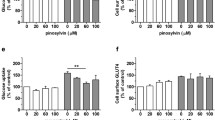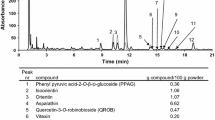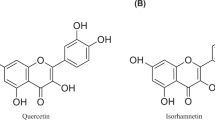Abstract
Skeletal muscle is a major tissue of glucose consumption and plays an important role in glucose homeostasis. Prenylflavonoids, a component of Macaranga tanarius fruits, have been reported to have antioxidant, antibacterial, and anticancer effects. However, the effects of these compounds on skeletal muscle glucose metabolism are unclear. Here, we isolated five prenylflavonoids from M. tanarius fruits, and investigated the mechanism of action of these compounds on skeletal muscle cells using L6 myotubes. We found that isonymphaeol B and 3′-geranyl naringenin increased glucose uptake in a dose-dependent manner. Furthermore, both isonymphaeol B and 3′-geranyl naringenin increased AMPK phosphorylation but did not affect PI3K-Akt phosphorylation. Isonymphaeol B and 3′-geranyl naringenin also increased Glut1 mRNA expression and plasma membrane GLUT1 protein levels. These results suggest that isonymphaeol B and 3′-geranyl naringenin have beneficial effects on glucose metabolism through AMPK and GLUT1 pathway. Isonymphaeol B and 3′-geranyl naringenin may be potential lead candidates for antidiabetic drug development.
Graphical abstract







Similar content being viewed by others
References
International Diabetes Federation (2019) IDF Diabetes Atlas, 9th edn. International Diabetes Federation, Brussels, Belgium
Kahn CR (1994) Banting Lecture. Insulin action, diabetogenes, and the cause of type II diabetes. Diabetes 43:1066–1084
UK Prospective Diabetes Study Group (1998) Intensive blood-glucose control with sulphonylureas or insulin compared with conventional treatment and risk of complications in patients with type 2 diabetes (UKPDS 33). Lancet 352:837–853
Smith AG, Muscat GE (2005) Skeletal muscle and nuclear hormone receptors: implications for cardiovascular and metabolic disease. Int J Biochem Cell Biol 37:2047–2063
DeFronzo RA, Gunnarsson R, Björkman O, Olsson M, Wahren J (1985) Effects of insulin on peripheral and splanchnic glucose metabolism in noninsulin-dependent (type II) diabetes mellitus. J Clin Invest 76:149–155
Joost HG, Thorens B (2001) The extended GLUT-family of sugar/polyol transport facilitators: nomenclature, sequence characteristics, and potential function of its novel members. Mol Membr Biol 18:247–256
Zaid H, Antonescu CN, Randhawa VK, Klip A (2008) Insulin action on glucose transporters through molecular switches, tracks and tethers. Biochem J 413:201–215
Minokoshi Y, Kahn CR, Kahn BB (2003) Tissue-specific ablation of the GLUT4 glucose transporter or the insulin receptor challenges assumptions about insulin action and glucose homeostasis. J Biol Chem 278:33609–33612
Olson AL, Pessin JE (1996) Structure, function, and regulation of the mammalian facilitative glucose transporter gene family. Annu Rev Nutr 16:235–256
Hardie DG (2008) AMPK: a key regulator of energy balance in the single cell and the whole organism. Int J Obes 32:S7–S12
Hwang JT, Kwon DY, Yoon SH (2009) AMP-activated protein kinase: a potential target for the diseases prevention by natural occurring polyphenols. N Biotechnol 26:17–22
Fogarty S, Hardie DG (2010) Development of protein kinase activators: AMPK as a target in metabolic disorders and cancer. Biochim Biophys Acta 1804:581–591
Song Y, Shi J, Wu Y, Han C, Zou J, Shi Y, Liu Z (2014) Metformin ameliorates insulin resistance in L6 rat skeletal muscle cells through upregulation of SIRT3. Chin Med J 127:1523–1529
Breen DM, Sanli T, Giacca A, Tsiani E (2008) Stimulation of muscle cell glucose uptake by resveratrol through sirtuins and AMPK. Biochem Biophys Res Commun 374:117–122
Na LX, Zhang YL, Li Y, Liu LY, Li R, Kong T, Sun CH (2011) Curcumin improves insulin resistance in skeletal muscle of rats. Nutr Metab Cardiovasc Dis 21:526–533
Kumazawa S, Nakamura J, Murase M, Miyagawa M, Ahn MR, Fukumoto S (2008) Plant origin of Okinawan propolis: honeybee behavior observation and phytochemical analysis. Naturwissenschaften 95:781–786
Kumazawa S, Murase M, Momose N, Fukumoto S (2014) Analysis of antioxidant prenylflavonoids in different parts of Macaranga tanarius, the plant origin of Okinawan propolis. Asian Pac J Trop Med 7:16–20
Kumazawa S, Ueda R, Hamasaka T, Fukumoto S, Fujimoto T, Nakayama T (2007) Antioxidant prenylated flavonoids from propolis collected in Okinawa, Japan. J Agric Food Chem 55:7722–7725
Lee JH, Kim YG, Khadke SK, Yamano A, Woo JT, Lee J (2019) Antimicrobial and antibiofilm activities of prenylated flavanones from Macaranga tanarius. Phytomedicine 63:153033
Shahinozzaman M, Taira N, Ishii T, Halim MA, Hossain MA, Tawata S (2018) Anti-inflammatory, anti-diabetic, and anti-alzheimer’s effects of prenylated flavonoids from okinawa propolis: an investigation by experimental and computational studies. Molecules 23:2479
Chen CN, Wu CL, Lin JK (2004) Propolin C from propolis induces apoptosis through activating caspases, Bid and cytochrome c release in human melanoma cells. Biochem Pharmacol 67:53–66
Chen CN, Weng MS, Wu CL, Lin JK (2004) Comparison of radical scavenging activity, cytotoxic effects and apoptosis induction in human melanoma cells by taiwanese propolis from different sources. Evid Based Complement Alternat Med 1:175–185
Yakushijin K, Shibayama K, Murata H, Furukawa H (1980) New prenylflavanones from Hernandia nymphaefolia (Presl) Kubitzki. Heterocycles 14:397–402
Jayasinghe L, Rupasinghe GK, Hara N, Fujimoto Y (2006) Geranylated phenolic constituents from the fruits of Artocarpus nobilis. Phytochemistry 67:1353–1358
Nishiumi S, Ashida H (2007) Rapid preparation of a plasma membrane fraction from adipocytes and muscle cells: application to detection of translocated glucose transporter 4 on the plasma membrane. Biosci Biotechnol Biochem 71:2343–2346
Al-Ishaq RK, Abotaleb M, Kubatka P, Kajo K, Büsselberg D (2019) Flavonoids and their anti-diabetic effects: cellular mechanisms and effects to improve blood sugar levels. Biomolecules 9:E430
Hendrich AB, Malon R, Pola A, Shirataki Y, Motohashi N, Michalak K (2002) Differential interaction of Sophora isoflavonoids with lipid bilayers. Eur J Pharm Sci 16:201–208
Tammela P, Laitinen L, Galkin A, Wennberg T, Heczko R, Vuorela H, Slotte JP, Vuorela P (2004) Permeability characteristics and membrane affinity of flavonoids and alkyl gallates in Caco-2 cells and in phospholipid vesicles. Arch Biochem Biophys 425:193–199
Mukai R, Fujikura Y, Murota K, Uehara M, Minekawa S, Matsui N, Kawamura T, Nemoto H, Terao J (2013) Prenylation enhances quercetin uptake and reduces efflux in Caco-2 cells and enhances tissue accumulation in mice fed long-term. J Nutr 143:1558–1564
Mukai R, Horikawa H, Fujikura Y, Kawamura T, Nemoto H, Nikawa T, Terao J (2012) Prevention of disuse muscle atrophy by dietary ingestion of 8-prenylnaringenin in denervated mice. PLoS ONE 7:e45048
Kretzschmar G, Zierau O, Wober J, Tischer S, Metz P, Vollmer G (2010) Prenylation has a compound specific effect on the estrogenicity of naringenin and genistein. J Steroid Biochem Mol Biol 118:1–6
Zhang WY, Lee JJ, Kim Y, Kim IS, Han JH, Lee SG, Ahn MJ, Jung SH, Myung CS (2012) Effect of eriodictyol on glucose uptake and insulin resistance in vitro. J Agric Food Chem 60:7652–7658
Zygmunt K, Faubert B, MacNeil J, Tsiani E (2010) Naringenin, a citrus flavonoid, increases muscle cell glucose uptake via AMPK. Biochem Biophys Res Commun 398:178–183
Huang WJ, Huang CH, Wu CL, Lin JK, Chen YW, Lin CL, Chuang SE, Huang CY, Chen CN (2007) Propolin G, a prenylflavanone, isolated from Taiwanese propolis, induces caspase-dependent apoptosis in brain cancer cells. J Agric Food Chem 55:7366–7376
Shetty M, Loeb JN, Vikstrom K, Ismail-Beigi F (1993) Rapid activation of GLUT-1 glucose transporter following inhibition of oxidative phosphorylation in clone 9 cells. J Biol Chem 268:17225–17232
Rubin D, Ismail-Beigi F (2003) Distribution of Glut1 in detergent-resistant membranes (DRMs) and non-DRM domains: effect of treatment with azide. Am J Physiol Cell Physiol 285:C377–C383
Barros LF, Barnes K, Ingram JC, Castro J, Porras OH, Baldwin SA (2001) Hyperosmotic shock induces both activation and translocation of glucose transporters in mammalian cells. Pflugers Arch 442:614–621
Barnes K, Ingram JC, Porras OH, Barros LF, Hudson ER, Fryer LG, Foufelle F, Carling D, Hardie DG, Baldwin SA (2002) Activation of GLUT1 by metabolic and osmotic stress: potential involvement of AMP-activated protein kinase (AMPK). J Cell Sci 115:2433–2442
Louters LL, Dyste SG, Frieswyk D, Tenharmsel A, Vander Kooy TO, Walters L, Whalen T (2006) Methylene blue stimulates 2-deoxyglucose uptake in L929 fibroblast cells. Life Sci 78:586–591
Kumar A, Xiao YP, Laipis PJ, Fletcher BS, Frost SC (2004) Glucose deprivation enhances targeting of GLUT1 to lipid rafts in 3T3-L1 adipocytes. Am J Physiol Endocrinol Metab 286:E568–E576
Roelofs B, Tidball A, Lindborg AE, TenHarmsel A, Vander Kooy TO, Louters LL (2006) Acute activation of glucose uptake by glucose deprivation in L929 fibroblast cells. Biochimie 88:1941–1946
Jing M, Ismail-Beigi F (2007) Critical role of 5’-AMP-activated protein kinase in the stimulation of glucose transport in response to inhibition of oxidative phosphorylation. Am J Physiol Cell Physiol 292:C477–C487
Jing M, Cheruvu VK, Ismail-Beigi F (2008) Stimulation of glucose transport in response to activation of distinct AMPK signaling pathways. Am J Physiol Cell Physiol 295:C1071–C1082
Ciaraldi TP, Mudaliar S, Barzin A, Macievic JA, Edelman SV, Park KS, Henry RR (2005) Skeletal muscle GLUT1 transporter protein expression and basal leg glucose uptake are reduced in type 2 diabetes. J Clin Endocrinol Metab 90:352–358
Farese RV, Sajan MP, Standaert ML (2005) Insulin-sensitive protein kinases (atypical protein kinase C and protein kinase B/Akt): actions and defects in obesity and type II diabetes. Exp Biol Med 230:593–605
Zhou G, Myers R, Li Y, Chen Y, Shen X, Fenyk-Melody J, Wu M, Ventre J, Doebber T, Fujii N, Musi N, Hirshman MF, Goodyear LJ, Moller DE (2001) Role of AMP-activated protein kinase in mechanism of metformin action. J Clin Invest 108:1167–1174
Fang H, Judd RL (2018) Adiponectin Regulation and Function. Compr Physiol 8:1031–1063
Srivastava RA, Pinkosky SL, Filippov S, Hanselman JC, Cramer CT, Newton RS (2012) AMP-activated protein kinase: an emerging drug target to regulate imbalances in lipid and carbohydrate metabolism to treat cardio-metabolic diseases. J Lipid Res 53:2490–2514
Benziane B, Björnholm M, Pirkmajer S, Austin RL, Kotova O, Viollet B, Zierath JR, Chibalin AV (2012) Activation of AMP-activated protein kinase stimulates Na+, K+-ATPase activity in skeletal muscle cells. J Biol Chem 287:23451–23463
Wu N, Zheng B, Shaywitz A, Dagon Y, Tower C, Bellinger G, Shen CH, Wen J, Asara J, McGraw TE, Kahn BB, Cantley LC (2013) AMPK-dependent degradation of TXNIP upon energy stress leads to enhanced glucose uptake via GLUT1. Mol Cell 49:1167–1175
Wright EM (2001) Renal Na(+)-glucose cotransporters. Am J Physiol Renal Physiol 280:F10–F18
Chen J, Williams S, Ho S, Loraine H, Hagan D, Whaley JM, Feder JN (2010) Quantitative PCR tissue expression profiling of the human SGLT2 gene and related family members. Diabetes Ther 1:57–92
Author information
Authors and Affiliations
Corresponding authors
Additional information
Publisher's Note
Springer Nature remains neutral with regard to jurisdictional claims in published maps and institutional affiliations.
Supplementary Information
Below is the link to the electronic supplementary material.
Rights and permissions
About this article
Cite this article
Natsume, N., Yonezawa, T., Saito, Y. et al. Prenylflavonoids from fruit of Macaranga tanarius promote glucose uptake via AMPK activation in L6 myotubes. J Nat Med 75, 813–823 (2021). https://doi.org/10.1007/s11418-021-01517-x
Received:
Accepted:
Published:
Issue Date:
DOI: https://doi.org/10.1007/s11418-021-01517-x




